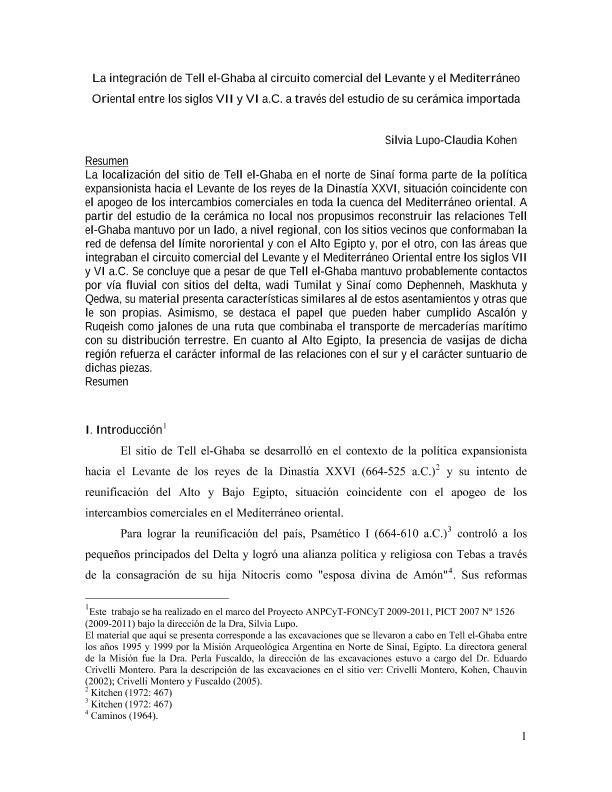Mostrar el registro sencillo del ítem
dc.contributor.author
Lupo, Silvia Alicia

dc.contributor.author
Kohen, Claudia Irene
dc.date.available
2016-02-03T16:00:00Z
dc.date.issued
2013-12
dc.identifier.citation
Lupo, Silvia Alicia; Kohen, Claudia Irene; La integración de Tell el-Ghaba al circuito comercial del Levante y el Mediterráneo Oriental entre los siglos VII y VI a.C. a través del estudio de su cerámica importada; Universidad de Buenos Aires. Facultad de Filosofía y Letras; Revista del Instituto de Historia Antigua Oriental; 16; 12-2013; 27-52
dc.identifier.issn
0325-1209
dc.identifier.uri
http://hdl.handle.net/11336/3993
dc.description.abstract
La localización del sitio de Tell el-Ghaba en el norte de Sinaí forma parte de la política expansionista hacia el Levante de los reyes de la Dinastía XXVI, situación coincidente con el apogeo de los intercambios comerciales en toda la cuenca del Mediterráneo oriental. A partir del estudio de la cerámica no local nos propusimos reconstruir las relaciones Tell el-Ghaba mantuvo por un lado, a nivel regional, con los sitios vecinos que conformaban la red de defensa del límite nororiental y con el Alto Egipto y, por el otro, con las áreas que integraban el circuito comercial del Levante y el Mediterráneo Oriental entre los siglos VII y VI a.C. Se concluye que a pesar de que Tell el-Ghaba mantuvo probablemente contactos por vía fluvial con sitios del delta, wadi Tumilat y Sinaí como Dephenneh, Maskhuta y Qedwa, su material presenta características similares al de estos asentamientos y otras que le son propias. Asimismo, se destaca el papel que pueden haber cumplido Ascalón y Ruqeish como jalones de una ruta que combinaba el transporte de mercaderías marítimo con su distribución terrestre. En cuanto al Alto Egipto, la presencia de vasijas de dicha región refuerza el carácter informal de las relaciones con el sur y el carácter suntuario de dichas piezas.
dc.description.abstract
Tell el-Ghaba’s settlement in the north of Sinai is part of the expansionary policy towards the Levant adopted by the kings of Dynasty 26 at a time when commercial Exchange across the Eastern Mediterranean was at its peak. By studying its non local pottery, we intended to reconstruct the interaction that Tell el-Ghaba had on the one hand, at a regional level, with its neighboring sites that belonged to the defense network of the northeastern border, as well as with Upper Egypt and, on the other hand, with the trade network of the Levant and the Eastern Mediterranean between the 7th and 6th centuries BC. The study revealed that although Tell el-Ghaba may have had contacts with sites located in the Delta, Wadi Tumilat and Sinai such as Dephenneh, Maskhuta and Qedwa by river, the material revealed characteristics not only similar to those of such settlements but also distinguishing characteristics of its own. It is also important to point out that Ashkelon and Ruqeish may have played a significant role as landmarks of a route that combined the carriage of goods by sea and their distribution by land. As for Upper Egypt, vessels from this region are full proof of the informal nature of the relations maintained with the south as well as the sumptuous nature of such pieces.
dc.format
application/pdf
dc.language.iso
spa
dc.publisher
Universidad de Buenos Aires. Facultad de Filosofía y Letras

dc.rights
info:eu-repo/semantics/openAccess
dc.rights.uri
https://creativecommons.org/licenses/by-nc-sa/2.5/ar/
dc.subject
Tell El-Ghaba
dc.subject
Cerámica Egipcia
dc.subject
Cerámica Importada
dc.subject
Intercambios
dc.subject.classification
Otras Historia y Arqueología

dc.subject.classification
Historia y Arqueología

dc.subject.classification
HUMANIDADES

dc.title
La integración de Tell el-Ghaba al circuito comercial del Levante y el Mediterráneo Oriental entre los siglos VII y VI a.C. a través del estudio de su cerámica importada
dc.type
info:eu-repo/semantics/article
dc.type
info:ar-repo/semantics/artículo
dc.type
info:eu-repo/semantics/publishedVersion
dc.date.updated
2016-03-30 10:35:44.97925-03
dc.journal.volume
16
dc.journal.pagination
27-52
dc.journal.pais
Argentina

dc.journal.ciudad
Buenos Aires
dc.description.fil
Fil: Lupo, Silvia Alicia. Consejo Nacional de Investigaciones Científicas y Técnicas. Oficina de Coordinación Administrativa Saavedra 15. Instituto Multidisciplinario de Historia y Ciencias Humanas; Argentina
dc.description.fil
Fil: Kohen, Claudia Irene. Consejo Nacional de Investigaciones Científicas y Técnicas. Oficina de Coordinación Administrativa Saavedra 15. Instituto Multidisciplinario de Historia y Ciencias Humanas; Argentina
dc.journal.title
Revista del Instituto de Historia Antigua Oriental
dc.relation.alternativeid
info:eu-repo/semantics/altIdentifier/url/http://goo.gl/CClGQZ
Archivos asociados
